Full name Paul Bunyan Occupation Lumberjack | Gender Male | |
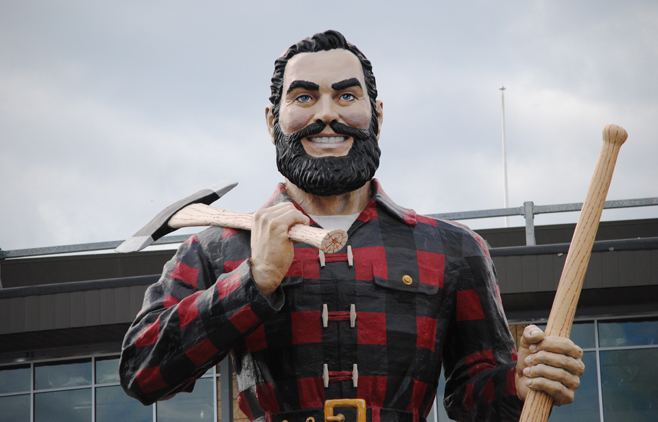 | ||
Birthplace Various claimed:Bangor, MaineAkeley, MinnesotaBemidji, MinnesotaBrainerd, MinnesotaOscoda, MichiganOssineke, MichiganSt. Ignace, Michigan Nationality French CanadianAmerican Movies Tall Tale, Lumber Jack-Rabbit Similar John Henry, Pecos Bill, Alfred Bulltop Stormalong, Joe Magarac, Br'er Rabbit | ||
Paul Bunyan is a giant lumberjack in American folklore. His exploits revolve around the tall tales of his superhuman labors, and he is customarily accompanied by Babe the Blue Ox. The character originated in the oral tradition of North American loggers, and was later popularized by freelance writer William B. Laughead (1882–1958) in a 1916 promotional pamphlet for the Red River Lumber Company. He has been the subject of various literary compositions, musical pieces, commercial works, and theatrical productions. His likeness is displayed in several statues across North America.
Contents
- Etymology
- In advertising and promotion
- Scholarly research
- Childrens adaptations
- Debated authenticity
- References
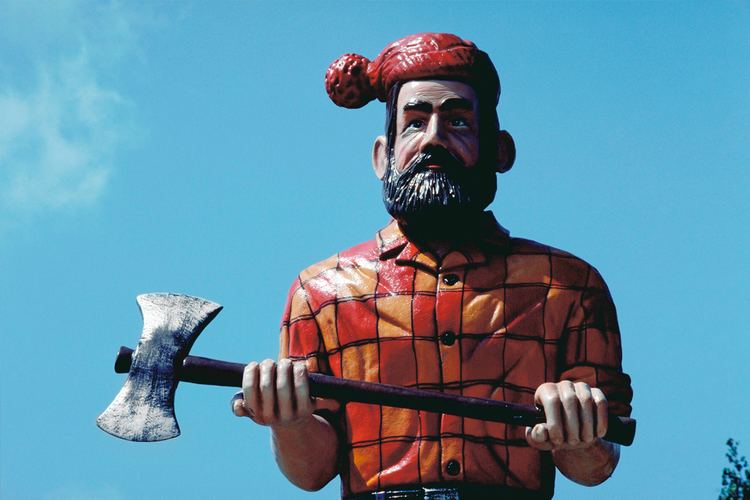
Etymology

There are many hypotheses about the etymology of the name Paul Bunyan. Much of the commentary focuses on a Franco-Canadian origin for the name. Phonetically Bunyan is similar to the Québécois expression "bon yenne!" expressing surprise or astonishment. The English surname Bunyan is derived from the same root as bunion in the Old French bugne, referring to a large lump or swelling. Several researchers have attempted to trace Paul Bunyan to the character of Bon Jean or Tit Jean of French Canadian folklore.
In advertising and promotion
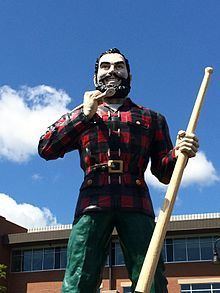
William B. Laughead, an independent adman, was the first to utilize Paul Bunyan for commercial use in a series of campaigns for the Red River Lumber Company. His first endeavor was a pamphlet entitled "Introducing Mr. Paul Bunyan of Westwood, California," but it did not prove effective. It was not until "Tales about Paul Bunyan, Vol. II" appeared that the campaign gained momentum. Embellishing older exploits and adding some of his own, Laughead's revamped Paul Bunyan did not stay faithful to the original folktales. Among other things, Laughead gave the name "Babe" to the blue ox, increased Paul Bunyan's height to impossible proportions, and created the first pictorial representation of Bunyan. This has led to significant confusion regarding the validity of Paul Bunyan as a genuine folkloric character. Nevertheless, the Laughead pamphlets are regarded as one of the most popular collections, often appearing in a single, unabridged volume entitled: The Marvelous Exploits of Paul Bunyan. The Red River ad campaign ingrained Paul Bunyan as a nationally recognized figure, and it also affirmed his massive marketing appeal. Throughout the better part of the century, Paul Bunyan's name and image continued to be utilized in promoting various products, cities, and services. Across North America, giant statues of Paul Bunyan were erected to promote local businesses and tourism. A significant portion of these were produced from the 1960s through the 1970s by the company International Fiberglass as part of their "Muffler Men" series of giant fiberglass sculptures. In 1996, Paul Bunyan was also referenced in the black comedy, "Fargo". Much was spoken about his popularity as well as Babe, the Blue Ox.
Scholarly research
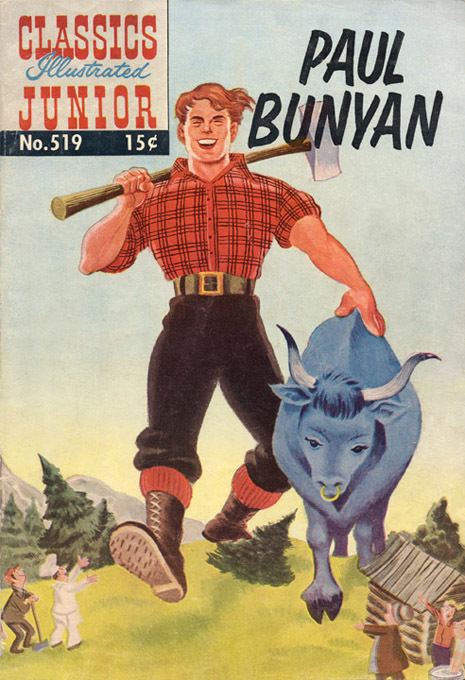
K. Bernice Stewart, a student at the University of Wisconsin, was working contemporaneously with Laughead to gather Paul Bunyan stories from woodsmen in the Midwest. Stewart was able to make a scholarly anthology of original anecdotes through a series of interviews. These were published as "Legends of Paul Bunyan, Lumberjack" in Transactions of the Wisconsin Academy of Sciences, Arts and Letters and coauthored by her English professor Homer A. Watt. The research relates traditional narratives, some in multiple versions, and goes on to conclude that many probably existed in some part before they were set to revolve around Bunyan as a central character. Stewart argued in her analysis that Paul Bunyan belongs to a class of traveler's tales.
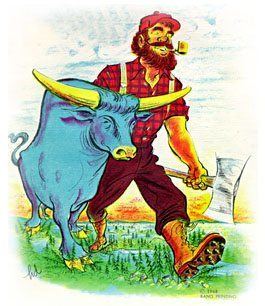
Charles E. Brown was the curator of the Museum of the State Historical Society of Wisconsin and secretary of the Wisconsin Archaeological Society. He was another principal researcher who recorded early Paul Bunyan stories from lumberjacks. He published these anecdotes in short pamphlet format for the use of students of folklore. Much of his research was financed through the government-funded Wisconsin Writers' Program.
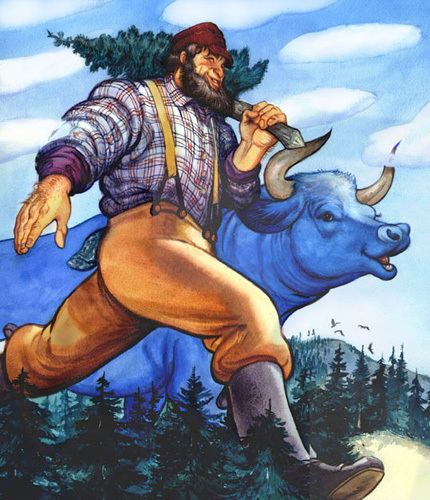
In 2007, Michael Edmonds of the Wisconsin Historical Society began a thorough reinvestigation of the Paul Bunyan tradition, publishing his findings in Out of the Northwoods: The Many Lives of Paul Bunyan. Edmonds concluded that Paul Bunyan had origins in the oral traditions of woodsmen working in Wisconsin camps during the turn of the 20th century, but such stories were heavily embellished and popularized by commercial interests.
Children's adaptations
Running at variance to his origins in folklore, the character of Paul Bunyan has become a fixture for juvenile audiences since his debut in print. Typical among such adaptations is the further embellishment of stories pulled directly from William B. Laughead's pamphlet, and with very few elements from oral tradition adapted into them. Nearly all of the literature is presented in long narrative format, exaggerates Paul Bunyan's height to colossal proportions, and follows him from infancy to adulthood.
Some of the more enduring collections of stories include Paul Bunyan by James Stevens, Paul Bunyan Swings His Axe by Dell J. McCormick, Paul Bunyan by Esther Shephard, Paul Bunyan and His Great Blue Ox by Wallace Wadsworth, and The Marvelous Exploits of Paul Bunyan by William Laughead.
Legends of Paul Bunyan (1947) was the first book published by the prolific tall tale writer Harold Felton.
In 1958 Walt Disney Studios produced Paul Bunyan as an animated short musical. The feature starred Thurl Ravenscroft, perhaps best known as the voice of Tony the Tiger for the Kellogg Company, and was nominated for Best Animated Short by the Academy Awards.
Debated authenticity
Commentators such as Carleton C. Ames, Marshall Fitwick, and particularly Richard Dorson cite Paul Bunyan as an example of "fakelore," a literary invention passed off as an older folktale. They point out that the majority of books about Paul Bunyan are composed almost entirely of elements with no basis in folklore, especially those targeted at juvenile audiences. Modern commercial writers are credited with setting Paul Bunyan on his rise to a nationally recognized figure, but this ignores the historical roots of the character in logging camps and forest industries.
At the same time, several authors have come forward to propose alternative origins for Paul Bunyan. D. Laurence Rogers and others have suggested a possible connection between Paul Bunyan tales and the exploits of French-Canadian lumberjack Fabian Fournier (1845 – 1875). From 1865 to 1875, Fournier worked for the H. M. Loud Company in the Grayling, Michigan area. James Stevens in his 1925 book Paul Bunyan makes another unverified claim that Paul Bunyan was a soldier in the Papineau Rebellion named Paul Bon Jean, and this is occasionally repeated in other accounts.
Stewart and Watt acknowledge that they have not yet succeeded in definitively finding out whether Bunyan actually lived or was wholly mythical. They have noted, however, that some of the older lumberjacks whom they interviewed claimed to have known him or members of his crew, and the supposed location of his grave was actually pointed out in northern Minnesota. In this regard, it should be noted that Bunyan's extreme gigantism was a later invention, and that early stories either do not mention it or, as in the Stewart and Watt paper, refer to him as being about seven feet tall.
Included in this section is a comparison chart between early Paul Bunyan references, the Stewart and Watt paper, and the Laughead advertisement.
